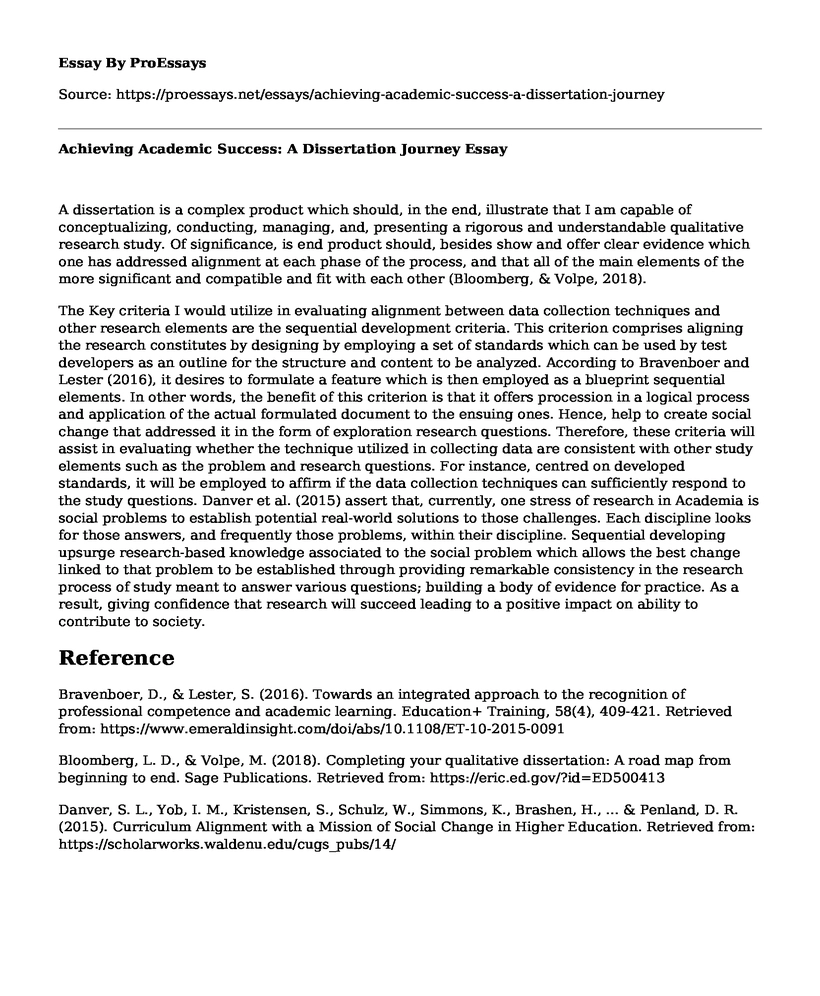A dissertation is a complex product which should, in the end, illustrate that I am capable of conceptualizing, conducting, managing, and, presenting a rigorous and understandable qualitative research study. Of significance, is end product should, besides show and offer clear evidence which one has addressed alignment at each phase of the process, and that all of the main elements of the more significant and compatible and fit with each other (Bloomberg, & Volpe, 2018).
The Key criteria I would utilize in evaluating alignment between data collection techniques and other research elements are the sequential development criteria. This criterion comprises aligning the research constitutes by designing by employing a set of standards which can be used by test developers as an outline for the structure and content to be analyzed. According to Bravenboer and Lester (2016), it desires to formulate a feature which is then employed as a blueprint sequential elements. In other words, the benefit of this criterion is that it offers procession in a logical process and application of the actual formulated document to the ensuing ones. Hence, help to create social change that addressed it in the form of exploration research questions. Therefore, these criteria will assist in evaluating whether the technique utilized in collecting data are consistent with other study elements such as the problem and research questions. For instance, centred on developed standards, it will be employed to affirm if the data collection techniques can sufficiently respond to the study questions. Danver et al. (2015) assert that, currently, one stress of research in Academia is social problems to establish potential real-world solutions to those challenges. Each discipline looks for those answers, and frequently those problems, within their discipline. Sequential developing upsurge research-based knowledge associated to the social problem which allows the best change linked to that problem to be established through providing remarkable consistency in the research process of study meant to answer various questions; building a body of evidence for practice. As a result, giving confidence that research will succeed leading to a positive impact on ability to contribute to society.
Reference
Bravenboer, D., & Lester, S. (2016). Towards an integrated approach to the recognition of professional competence and academic learning. Education+ Training, 58(4), 409-421. Retrieved from: https://www.emeraldinsight.com/doi/abs/10.1108/ET-10-2015-0091
Bloomberg, L. D., & Volpe, M. (2018). Completing your qualitative dissertation: A road map from beginning to end. Sage Publications. Retrieved from: https://eric.ed.gov/?id=ED500413
Danver, S. L., Yob, I. M., Kristensen, S., Schulz, W., Simmons, K., Brashen, H., ... & Penland, D. R. (2015). Curriculum Alignment with a Mission of Social Change in Higher Education. Retrieved from: https://scholarworks.waldenu.edu/cugs_pubs/14/
Cite this page
Achieving Academic Success: A Dissertation Journey. (2023, Jan 04). Retrieved from https://proessays.net/essays/achieving-academic-success-a-dissertation-journey
If you are the original author of this essay and no longer wish to have it published on the ProEssays website, please click below to request its removal:
- Learning and Your Life, Essentials of Student Success by Robert S. Feldman Essay
- Should Children Carry Cell Phones To School? - Essay Sample
- Should School Require Uniforms? - Essay Sample
- Community Service Work Experience Paper Example
- Teaching Kids Moral Values: Essential for Self-Realization and Social Control - Essay Sample
- Essay Example on Cyberbullying: Analysis and Critical Interpretation
- Free Paper on Adderall Abuse Among College Students: Causes, Effects, and Societal Concerns







